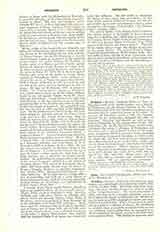

Ortelius (OERTEL), ABRAHAM, cartographer, geographer, and archaeologist, b. in Antwerp, April 4, 1527; d. there, June 28, 1598. His family came from Augsburg, wherefore Ortelius frequently referred to himself as “Belgo-Germanus”. The death of his father in 1535, who had been a wealthy merchant, seems to have placed the family in difficulties, for Ortelius began to trade or peddle geographical charts and maps while still a mere youth. When twenty years of age he joined a guild as a colorer of charts. By purchasing as valuable maps as possible, mounting them on canvas, coloring, and reselling them, he managed to assist in supporting the family, as may be gleaned from a contemporary letter. This trading in maps was probably one of the chief reasons for his unusually extended trips to Germany, England, Italy, and particularly for his annual visits to the great fair at Leipzig. Mean-while he did not confine himself entirely to trafficking in charts. Five years before Mercator published his famous Carta Navigatoria (1569) appeared Ortelius’s great eight-leaved map of the world. As the only extant copy of this great map is that in the library of the University of Basle (cf. Bernoulli, “Ein Karteninkunabelnband”, Basle, 1905, p. 5) it is still almost entirely unknown. No copy has yet been found of Ortelius’s great map of Asia, but in his chief work, which assures him for all time a place of honor in the history of cartography, we find not only his own map of Asia on a smaller scale, but also a number of maps of other cartographers, who otherwise are completely unknown. This work is the “Theatrum orbis terrarum”, which appeared in 1570; it was the first great modern atlas, and contained seventy copper engravings on fifty-three double-folio pages. Ortelius has combined in this work in a systematic manner all recent maps of the world and separate countries, of which he had heard during his long activity as trader and collector. Where several maps of one country were available, he chose the most modern and most reliable copy. When the name of the author was mentioned on the map, Ortelius did not change a line or a name then, but, when the author’s name was not given, he resolutely made such changes as appeared to him necessary. He conscientiously gave credit to the author of maps which were published on a reduced scale by himself. Considering geography as an eye of history (historiae oculus), he usually added the ancient historical names of countries and cities to the modern ones.
To the atlas he appended a geographical dictionary which contained both the ancient and modern names. More important for us than this dictionary is the appended catalogue of maps (Catalogus auctorum tabularum geographicarum), in which appear the names and works of ninety-nine cartographers who lived before 1570. As concerning many of these cartographers we have no other knowledge than that contained in this catalogue, and as Ortelius utilized but forty-six of the maps mentioned by him, this little list is today one of the most important sources for a history of cartography. Later on this “Theatrum” was enlarged and improved. In 1593 there were 137, in 1612 no less than 166 maps, while the list of authors reached 183 for the time up to 1595; antiquated maps were replaced by more modern ones, or changed according to the more accurate reports forwarded for the most part by missionaries, and it soon appeared not only in the Latin language, but also in Dutch, High German, Italian, and French translations. Very numerous were the smaller editions and extracts in the various languages. As late as 1697 there appeared in Venice a “Teatro del Mondo di Abramo Ortelio”. As the
“Theatrum” had been dedicated to the Spanish king Philip II by Ortelius, the latter was given the title of a Royal Geographer (geographus regius). His contemporaries honored him as the “Ptolemy of his century”. Separate from his atlas Ortelius published in 1587 the “Thesaurus geographicus”, which possesses to this day considerable value as a dictionary of old geography. In the form of a letter to his friend Gerhard Mercator, Ortelius published in 1575 his “Itinerarium per nonnullas Galliae Belgicae partes”, which contains much valuable information as to the old geography of Belgium, but which is chiefly valuable on account of its philologico-archaeological importance. One of the fruits of his restless activity as a collector of archaeological specimens was his pamphlet: “Deorum, Dearumque Capita e veteribus numismatibus” (1575), which contained a number of reproductions from his widely admired archaeological collection. In his “Aurei seculi imago sive Germanorum veterum mores, ritus et religio delineata et commentariis ex utriusque linguae scriptoribus descripta”, he gives a short commentary to the works of ancient writers on Germany, illustrated with ten engravings. Despite the great honor freely accorded to Ortelius, he remained humble and modest. “Until his very end he was”, as F. Ratzel says, “a good Catholic and had particularly many friends among the Jesuits”. True to his motto, “Contemno et orno [mundum], mente, manu”, Ortelius, unmarried and earnest, remained above the petty squabbles which so often disturb scientific circles. “Quietis cultor sine lite, uxore, prole” is written on his tombstone in the Praemonstratensian abbey at Antwerp. This epitaph was written by Justus Lipsius.
JOSEPH FISCHER

